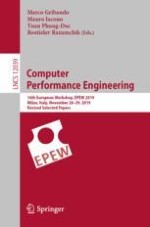2020 | Buch
Computer Performance Engineering
16th European Workshop, EPEW 2019, Milan, Italy, November 28–29, 2019, Revised Selected Papers
herausgegeben von: Marco Gribaudo, Mauro Iacono, Tuan Phung-Duc, Rostislav Razumchik
Verlag: Springer International Publishing
Buchreihe : Lecture Notes in Computer Science
